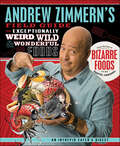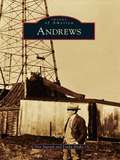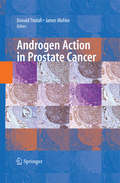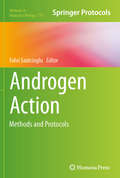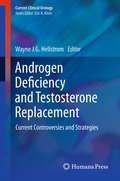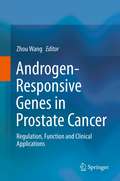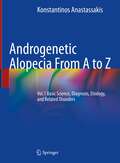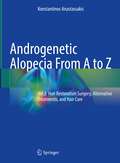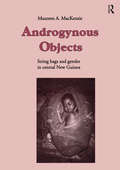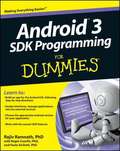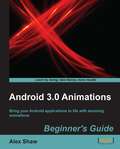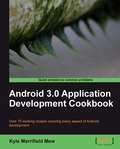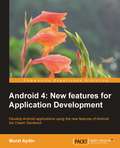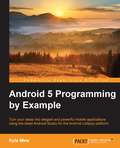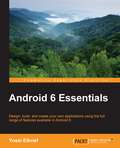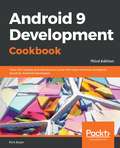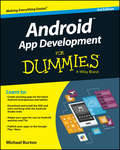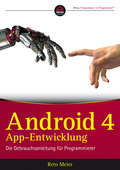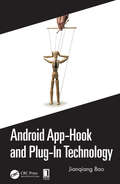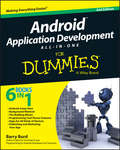- Table View
- List View
Andrew Zimmern's Field Guide to Exceptionally Weird, Wild, & Wonderful Foods: An Intrepid Eater's Digest
by Andrew ZimmernAndrew Zimmern loves food. In fact, there's practically nothing he won't try--at least once. As host of Bizarre Foods with Andrew Zimmern and Andrew Zimmern's Bizarre Foods America on the Travel Channel, Andrew's passion is exploring how different foods are important to different cultures. Now, Andrew is sharing his most hilarious culinary experiences--as well as fun facts about culture, geography, art, and history, to name a few--with readers of all ages. Don't like broccoli? Well, what if you were served up a plate of brains, instead? From alligator meat to wildebeest, this digest of Andrew's most memorable weird, wild, and wonderful foods will fascinate and delight eaters of all ages, intrepid and...not so much.
Andrews (Images of America)
by Linda Drake Don IngramAndrews County was named for Richard Andrews, the first casualty in Texas's fight for independence from Mexico in 1835 at the battle of Concepción. Before the creation of the county in 1876 by the Texas legislature, the area had been largely ignored by state officials and avoided by ranchers and settlers because of its remoteness, scarcity of water, and attacks by local Native Americans. That all changed in 1875 after an expedition by U.S. cavalry troops led by Col. William R. Shafter opened the region up to settlers. The town of Andrews became the county seat in 1910 after a close election race with nearby Shafter Lake. Ranching was the first economic driver in the county, but the discovery of oil in 1929 changed everything. The oil boom created jobs, brought in revenue, and attracted new residents. Today Andrews is experiencing growth thanks to renewed demand for oil, nuclear-related industries, first-class sporting venues, and other amenities that have rejuvenated the community.
Andrews' Diseases of the Skin: Clinical Dermatology
by William D. James Dirk M. Elston Timothy G. BergerEffectively diagnose and treat a wide range of skin conditions with the latest edition of the highly regarded Andrews' Diseases of the Skin: Clinical Dermatology. The 12th edition of this classic reference, by esteemed authors William D. James, MD, Timothy G. Berger, MD, and Dirk M. Elston, MD, provides state-of-the-art information on newly recognized diseases, new conditions, and unusual variants of well-known diseases, as well as new uses for tried-and-true medications and unique drugs for diseases as disparate as melanoma and rosacea. It's your ideal go-to resource for clinical dermatology, at every stage of your career.
Androcles and the Lion (Rigby PM Collection Sapphire (Levels 29-30), Fountas & Pinnell Select Collections Grade 3 Level Q)
by Jenny GilesAndrocles and the Lion Retold by Jenny Giles Illustrated by Loma Tilders
Androgen Action in Prostate Cancer
by James Mohler Donald TindallAndrogens are critical regulators of prostate differentiation and function, as well as prostate cancer growth and survival. Therefore, androgen ablation is the preferred systemic treatment for disseminated prostate cancer. Androgen action is exerted in target tissues via binding the androgen receptor (AR), a nuclear receptor transcription factor. Historically, the gene expression program mediated by the AR has been poorly understood. However, recent gene expression profiling and more traditional single-gene characterization studies have revealed many androgen-regulated genes that are important mediators of androgen action in both normal and malignant prostate tissue. This book will focus on the androgen-regulated gene expression program, and examine how recently identified androgen-regulated genes are likely to contribute to the development and progression of prostate cancer. Recent studies that have attempted to unravel how these genes are deregulated in androgen depletion independent prostate cancer will be included
Androgen Action: Methods and Protocols (Methods in Molecular Biology #776)
by Fahri SaatciogluAndrogens play a critical role in the development and maintenance of the male reproductive system and affect important physiological processes and pathological conditions, including the homeostasis of the normal prostate and prostate cancer. Androgen Action: Methods and Protocols is designed to provide a tool box to study various phases of androgen action, from its entry to the cell to the phenotypic response that the cell mounts, with up-to-date techniques for biochemists, molecular biologists, cell biologists, geneticists, and pathologists. The volume opens with a brief review of the research history on androgen action and prostate carcinogenesis, followed by chapters that cover state-of-the-art methods to determine androgen levels in biological tissues and fluids, experimental procedures to study the various aspects of androgen receptor activity, and methodology to study salient examples of interactions between androgen signalling and other major signalling pathways in cells. Written in the successful Methods in Molecular BiologyTM series format, chapters include introductions to their respective topics, lists of the necessary materials and reagents, step-by-step, readily reproducible protocols, and notes on troubleshooting and avoiding known pitfalls. Authoritative and easily accessible, Androgen Action: Methods and Protocols provides a comprehensive overview of, and practical guidance on, the diverse methodologies that are propelling androgen action research forward, both for normal physiology as well as in disease states.
Androgen Deficiency and Testosterone Replacement: Current Controversies and Strategies (Current Clinical Urology)
by Wayne J.G. HellstromAndrogen Deficiency and Testosterone Replacement: Current Controversies and Strategies explores the difficulties around the diagnosis and treatment of androgen deficiency. The text examines the available evidence concerning the diagnosis and treatment of men with low testosterone. It also examines controversies in the identification and management of these men. While the information contained within will be of use to those who specialize in androgen deficiency and sexual medicine, the scope of the book will serve as a source of basic information about testosterone replacement and as a source of reasoned analysis of the controversies surrounding testosterone replacement in the aging male. Physicians and physician extenders will be able to apply evidence management principles to the evaluation and treatment of men with testosterone deficiency; supported by the most recent practice guidelines available. The authors represent a select group of physicians with expertise in androgen deficiency and replacement. Androgen Deficiency and Testosterone Replacement: Current Controversies and Strategies will be of great value to all physicians and physician extenders who deliver health care to men of all ages.
Androgen-Responsive Genes in Prostate Cancer: Regulation, Function and Clinical Applications
by Zhou WangAndrogens and androgen receptors (AR) play critical roles in the development and progression of prostate cancer, the most frequently diagnosed cancer and second leading cause of cancer death in US males. AR is an androgen-dependent DNA-binding transcription factor that regulates the expression of androgen-responsive genes. Identification and characterization of androgen-responsive genes provide insights into the cellular mechanisms of androgen action and may lead to new approaches in diagnosis, prognosis, prevention and/or treatment of prostate cancer. This volume provides critical information from well respected experts in the field. Some of the exciting topics include the new understanding of mechanisms underlining the regulation of androgen-responsive gene expression, and functions of various androgen-responsive genes in biological processes essential in carcinogenesis including cell growth, angiogenesis, and epithelial-to-mesenchyme transition (EMT). Other important aspects addressed are the current and potential clinic applications of knowledge on androgen-responsive gene regulation and function. This book is intended for researchers, scientists, faculty, and advanced graduate students with an interest in androgen action and prostate cancer.
Androgenetic Alopecia From A to Z: Vol. 2 Drugs, Herbs, Nutrition and Supplements
by Konstantinos AnastassakisThis second of three related volumes, designed as a reference tool for the understanding and treatment of Androgenetic Alopecia and Female Pattern Hair Loss (AGA/FPHL), is structured in 4 sections: 63 dedicated chapters covering every aspect of medical (non-surgical, non-invasive) and nutritional treatment options and clinical effects. FDA-approved hair growth drugs, every frequently prescribed "off-label" or experimental drug, hormones, cosmeceuticals, and popular fraudulent controversial products are all presented in 26 chapters, with figures, tables, algorithms, and thousands of fully updated and balanced literature citations. Filling a gap in the latest literature, Androgenetic Alopecia From A to Z: Drugs, Herbs, Nutrition, and Supplements includes a thorough review of lifestyle and nutritional factors specifically affecting AGA/FPHL, including excessive caloric intake, high-fat diets, caloric deprivation, alcohol abuse, and smoking. The intricate effects of nutrition on hair loss, one of the most neglected and misunderstood fields in Dermatology, are presented as well, with a plethora of clinically valuable information: why food supplements are so popular, the regulatory minefield of supplements, and the life-threatening perils of nutritional supplementation, are all reviewed extensively. Each vitamin, major mineral, and trace element implicated in follicular physiology is reviewed in altogether 24 dedicated chapters according to their specific effects on the hair follicle, food sources, dietary recommendations, and the impact of deficiency or excess. This volume includes a comprehensive chapter on the understanding of Complementary-Alternative Medicine (CAM). CAM is an umbrella term for methods that lie outside evidence-based medicine and a part of a societal trend towards the rejection of science as a method of determining facts. The pitfalls and challenges in understanding botanicals with reported hair growth properties, from publication bias to lack of standardization, as well as their unpredictable pharmacological and physiological effects, are all explained in detail. Finally, all popular botanical products reported to possess hair growth properties are appraised in 14 dedicated chapters, each including a detailed review of the general effects, the suggested biochemical mechanisms, claimed actions on the hair follicle, all available studies, and hundreds of literature citations. This carefully crafted book will be an invaluable reference tool for dermatologists and all clinical practitioners dealing with Androgenetic Alopecia and Female Pattern Hair Loss and will help them answer challenging patient questions, debunk myths on hair growth drugs, and supplements and navigate patients towards effective and safe treatment schemes.
Androgenetic Alopecia From A to Z: Vol.1 Basic Science, Diagnosis, Etiology, and Related Disorders
by Konstantinos AnastassakisThis reference volume conveys complete understanding and management of Androgenetic Alopecia and Female Pattern Hair Loss (AGA/FPHL). These are probably the most common adult (18-50 yrs.) health disorders besides dental caries, accounting for over 98% of hair loss cases in males and over 70% cases in females. The present volume, the first of three related volumes, is structured in 4 sections: 22 dedicated chapters, ranging from basic science (Biology, Anatomy, Physiology, Embryology), the etiology of adult, childhood & adolescent AGA/FPHL, diagnostic steps and evaluation, to related disorders and comorbidities. For the first time in the scientific literature, all pathogenic contributors of AGA/FPHL, including micro-inflammation, scalp vascularization, biochemical stress, aging, solar radiation, and the sebaceous gland, are examined in comprehensive, dedicated chapters. The effects of every hormone on AGA/FPHL, as well as the psychological impact of the condition, are explored in depth. An extensive chapter on childhood and adolescent AGA/FPHL, a more common than previously thought condition, is another unique feature. Finally, two extremely detailed sections are included on the pathogenic links of AGA/FPHL to life-threatening comorbidities: cardiovascular disease, metabolic syndrome, hypertension, insulin resistance, and prostatic disorders, with suggested guidelines on how to save lives of balding patients by adopting early screening strategies. In providing a fully updated, thorough guide to this popular topic, this richly illustrated volume (over 200 figures, tables, and algorithms) offers the latest, evidence-based information on every aspect of AGA/FPHL causing hair loss to countless patients. Each subject is addressed according to learning and clinical needs, and the presented information is supported by a wealth of peer-reviewed papers. Every aspect of this condition is considered, including biology, diagnosis, etiology, from drug treatment, the influence of nutrition, lifestyle and food supplements, to related disorders, surgical hair restoration, hair care, and future treatment options. This handbook will be an invaluable conveying best management standards to readers, whether experienced practitioners, clinicians, dermatologists, surgeons or researchers interested in hair restoration.
Androgenetic Alopecia From A to Z: Vol.3 Hair Restoration Surgery, Alternative Treatments, and Hair Care
by Konstantinos AnastassakisThis third of three related volumes is structured in 3 sections and 46 chapters covering every aspect of Hair Restoration Surgery (HRS), alternative and future treatments for AGA/FPHL, as well as hair loss concealment and hair care. The reader will find dedicated chapters on every aspect of HRS: from the initial, "prehistoric" HRS techniques that have cosmetically stigmatized countless patients and defamed the field to in-depth coverage of all modern HRS techniques endorsing a "cosmetic revolution". Modern HRS techniques that offer results indistinguishable from natural hair in male and female patients are described in detail, with invaluable surgical pearls and strategies on how to treat complications, repair substandard results and even how to build a successful HRS practice. Chapters include more than a thousand original and unique full-color photos of unique cases, figures, tables, and invaluable surgical tips. The safety and applicability of Low Level Laser Therapy, Genetic Engineering/Gene Therapy, Stem Cell Therapy, Hair Follicle Cloning, Platelet Rich Plasma, Scalp Microneedling and Exosomes on AGA/FPHL are thoroughly reviewed in dedicated chapters, validated by several updated and balanced literature citations. All types of cover-up products that can "camouflage" baldness are reviewed in detail through the author's vast experience in their clinical use. An elaborate chapter on hair prosthesis and wigs illustrates how patients with extensive AGA can have a natural appearance and unrestricted life. The psychological entrapment, social awkwardness, hidden costs, and downsides of the wig industry are assessed. Finally, details on hair hygiene and how they can drastically affect hair loss are offered in a separate chapter. Handy, thorough, and practical, Androgenetic Alopecia From A to Z, Hair Restoration Surgery and Alternative Treatments Volume 3 will meet the needs of dermatologists, plastic surgeons, general practitioners, and all other physicians involved in this fast growing and fascinating field.
Androgens in Gynecological Practice
by Leo PlouffeA practical approach to the field of androgen excess or deprivation in women's health. The content includes multiple viewpoints on the most common disorders in this class, such as polycystic ovary disease, hirsutism and menopausal issues. Each chapter provides a combination of long-lasting clinical principles in the diagnosis and management of these patients along with a state-of-the-art review. This text takes an innovative approach to uncommon conditions (such as congenital adrenal hyperplasia, transgender conditions). In addition to presenting clinical insights, and a review of the basic science underpinning these conditions, it focuses on key concepts that can be derived from these rare conditions to the entire field. This book is an essential addition to the library for any busy clinician who is looking for a practical reference guide but also for the sub-specialist who is looking for new and thought-provoking insights in this complex scientific area.
Androgynous Objects: String Bags and Gender in Central New Guinea (Studies in Anthropology and History #Vol. 2)
by Maureen A. MacKenzieAndrogynous Objects explores the way meaning is encoded in material culture by focusing on the androgynous symbolism of the looped string bag, or bilum, of the Telefol people of Central New Guinea. The web of meanings 'woven' into the bag is shown to extend beyond women's lives and bodies. It is open to manipulation and reformation in a variety of contexts and is used by both Telefol women and men to explore, and so explain the complexities and ambiguities inherent in their social life.
Android 3 SDK Programming For Dummies
by Rajiv Ramnath Roger Crawfis Paolo SivilottiGet quickly up to speed with the latest Android SDK Aimed at object oriented programmers, this straightforward-but-fun book serves as the most efficient way to understand Android, update an existing Android application, port a mobile application from another environment, or simply learn the ins and outs of the latest Android SDK. Packed with all the code and modules featured throughout, this guide also includes tutorials, tests, and project ideas. The authors forego the unnecessary repetition of material you already know and instead cut straight to the essentials such as interacting with hardware, getting familiar with the operating system, and networking. You'll walk through the process of designing, building, running, and debugging the application while you also learn Android best practices. Demonstrates a wide variety of Android features, including user interface design, application management, data and content management, and incorporating external services Organizes the many packages of the Android SDK by functionality and details which standards and features are appropriate for each level of the Android SDK Explains the new features of the latest Android SDK with examples and snippets that demonstrate how to effectively incorporate the features into new or existing applications Features all programming examples, including the sample application, on the companion web site Android 3 SDK Programming For Dummies is written in clear, plain English to help you quickly understand and program the latest Android SDK.
Android 3.0 Animations: Beginner’s Guide
by Alex ShawWritten in Packt's Beginner's Guide series, this book takes a step-by-step approach with each chapter made up of three to five tutorials that introduce and explain different animation concepts. All concepts are explained with real-world examples that are fun to read and work with. If you are familiar with developing Android applications and want to bring your apps to life by adding smashing animations, then this book is for you. The book assumes that you are comfortable with Java development and have familiarity with creating Android Views in XML and Java. The tutorials assume that you will want to work with Eclipse, but you can work just as well with your preferred development tools.
Android 3.0 Application Development Cookbook
by Kyle Merrifield MewThe book is written in a cookbook style, presenting examples in the style of recipes, allowing you to go directly to your topic of interest, or follow topics throughout a chapter to gain in-depth knowledge.If you are new to Android application development and looking for a quick start, or if you are an experienced Android developer looking for a reference guide, then this book is for you. Ideally, you should know some Java and a little about mark-up languages but this is by no means necessary. This book will teach you how to write rich Android applications from scratch in no time.
Android 4: New Features for Application Development
by Murat AydinThis is a practical and hands-on guide with a step-by-step approach and clearly explained sample code. This book is for developers who are experienced with the Android platform, but who may not be familiar with the new features and APIs of Android 4.0. Android developers who want to learn about supporting multiple screen sizes and multiple Android versions will also find this book beneficial.
Android 5 Programming by Example
by Kyle MewIf you have a great idea for a mobile app, and some familiarity with Java, or a similar procedural programming language, then all you need is this book to turn your idea into a reality.
Android 6 Essentials
by Yossi ElkriefDesign, build, and create your own applications using the full range of features available in Android 6 About This Book * Learn how to utilize the robust features of Android 6 to design, develop, and publish better Android applications * Get useful guidance on creating new apps or migrating existing apps to support features such as app permissions, app links, fingerprint authentication, etc * A fast paced guide, packed with hands-on examples that ties all the features such as API, audio, video, camera, tab customization together under a single cover Who This Book Is For This book is for Android developers who are looking to move their applications into the next Android version with ease. What You Will Learn * Familiarize yourself with the features of Android 6 * Code with the new Android permissions model * Use apps auto backup and restore lost data automatically * Increase user engagement with apps through an assistant using triggers and providing contextual assistance * Assess and handle proper usage of the API * Work with Audio, Video,Camera in Android 6 * Utilize the new features in Android for professional purposes * Understand and code Chrome's custom tabs In Detail Android 6 is the latest and greatest version of the Android operating system, and comes packed with cutting edge new features for you to harness for the benefit of building better applications. This step-by-step guide will take you through the basics of the Android Marshmallow permissions model and beyond into other crucial areas such as the Audio,Video,Camera API and Android's at work features. Learn how to create, deploy, and manage Android applications with Marshmallow's API and the latest functionalities. The combination of instructions and real-world examples will make your application deployment and testing a breeze. Style and approach This easy-to-follow, step-by-step tutorial provides explanations and examples to add the new Android 6 features to your skill set. Each chapter provides sequential steps and detailed information about the API, as well as best practices and testing options.
Android 9 Development Cookbook: Over 100 recipes and solutions to solve the most common problems faced by Android developers, 3rd Edition (02 RRP including tax)
by Rick BoyerBuild feature-rich, reliable Android Pie apps with the help of more than 100 proven industry standard recipes and strategies.Key FeaturesUncover the latest features in Android 9 Pie to make your applications stand outDevelop Android Pie applications with the latest mobile technologies, from set up to securityGet up-to-speed with Android Studio 3 and its impressive new featuresBook DescriptionThe Android OS has the largest installation base of any operating system in the world. There has never been a better time to learn Android development to write your own applications, or to make your own contributions to the open source community! With this extensively updated cookbook, you'll find solutions for working with the user interfaces, multitouch gestures, location awareness, web services, and device features such as the phone, camera, and accelerometer. You also get useful steps on packaging your app for the Android Market. Each recipe provides a clear solution and sample code you can use in your project from the outset. Whether you are writing your first app or your hundredth, this is a book that you will come back to time and time again, with its many tips and tricks on the rich features of Android Pie.What you will learnDevelop applications using the latest Android framework while maintaining backward-compatibility with the support libraryCreate engaging applications using knowledge gained from recipes on graphics, animations, and multimediaWork through succinct steps on specifics that will help you complete your project fasterAdd location awareness to your own app with examples using the latest Google Play services APIUtilize Google Speech Recognition APIs for your appWho this book is forIf you are new to Android development and want to take a hands-on approach to learning the framework, or if you are an experienced developer in need of clear working code to solve the many challenges in Android development, you will benefit from this book. Either way, this is a resource you'll want to keep on your desk as a quick reference to help you solve new problems as you tackle more challenging projects.
Android App Development For Dummies
by Michael BurtonThe updated edition of the bestselling guide to Android app development If you have ambitions to build an Android app, this hands-on guide gives you everything you need to dig into the development process and turn your great idea into a reality! In this new edition of Android App Development For Dummies, you'll find easy-to-follow access to the latest programming techniques that take advantage of the new features of the Android operating system. Plus, two programs are provided: a simple program to get you started and an intermediate program that uses more advanced aspects of the Android platform. Android mobile devices currently account for nearly 80% of mobile phone market share worldwide, making it the best platform to reach the widest possible audience. With the help of this friendly guide, developers of all stripes will quickly find out how to install the tools they need, design a good user interface, grasp the design differences between phone and tablet applications, handle user input, avoid common pitfalls, and turn a "meh" app into one that garners applause. Create seriously cool apps for the latest Android smartphones and tablets Adapt your existing apps for use on an Android device Start working with programs and tools to create Android apps Publish your apps to the Google Play Store Whether you're a new or veteran programmer, Android App Development For Dummies will have you up and running with the ins and outs of the Android platform in no time.
Android App Entwicklung für Dummies (Für Dummies)
by Donn Felker Michael BurtonDie ganze Welt der Android App Entwicklung in einem Buch Haben Sie eine kreative Idee für eine eigene App und Vorkenntnisse in Java und XML? Dann erfahren Sie in diesem Buch, wie Sie Ihre Idee umsetzen und eine App mit allen Schikanen für Android-Smartphones programmieren können. Der Autor erklärt, wie Sie die kostenlosen Programme Android Studio und Java Development Kit herunterladen, wie Sie den Emulator nutzen und wie Sie Ihre App im Google Play Store veröffentlichen. Schritt für Schritt erläutert er anhand von zwei Beispielen das Know-how der App Entwicklung. Außerdem erklärt er Ihnen, wie Sie Ihre App für Tablets optimieren. Die vollständigen Quelltexte werden zum Download angeboten. Legen Sie los!
Android App-Entwicklung: Die Gebrauchsanleitung für Programmierer
by Reto MeierInformationen für Android-Entwickler aus erster Hand: Reto Meier, Android Developer Relations Tech Lead bei Google, zeigt Ihnen in diesem genauso umfassenden wie verständlichen Kompendium alles, was Sie für den Einstieg in die Entwicklung von Android-Apps und die tägliche Praxis wissen müssen - angefangen bei den benötigten Entwicklungstools und dem Grundaufbau von Android-Apps über das Design von Benutzeroberflächen bis zum Umgang mit Telefonie und SMS. Natürlich erhalten Sie auch ausführliche Informationen zum Zugriff auf Gerätesensoren, Kamera, Audio und Video, zur Nutzung von Karten und ortsbezogenen Daten sowie Bluetooth und WiFi - alles an typischen Anwendungsbeispielen anschaulich erklärt. Zum Abschluss erfahren Sie dann noch, wie Sie Ihre Apps nicht nur veröffentlichen, sondern auch noch Geld mit ihnen verdienen. Um Sie optimal zu unterstützen, erhalten Sie den Code sämtlicher Beispiele zum praktischen Download.
Android App-Hook and Plug-In Technology
by Jianqiang BaoThis book presents the Android plug-in technology used in Android development. This technology is widely used by a majority of Chinese internet companies, and is becoming more widely used worldwide. The book fully describes the history of Android plug-in technology, the installation and startup process, and new features of the Android plug-in technology. It also explores plug-in solutions for peripheral technologies. The book is designed to help Android app developers better understand the underlying technology of the Android system. Features Introduces Android system knowledge, including the communication between AMS and four components Describes the Hook technique by Proxy.newProxyInstance and reflection, to modify Android system behavior, for example, to launch an activity not declared in the AndroidManifest. Shows how to use the Hook apk packaging process in Gradle Covers how to merge the resources in the plugin app and the host app, and how to merge dex of the host app and all the plugin apps Presents the SO technique and how to launch SO files dynamically
Android Application Development All-in-One For Dummies
by Barry BurdA must-have pedagogical resource from an expert Java educator As a Linux-based operating system designed for mobile devices, the Android OS allows programs to run on all Android devices and appear free in the Android Market. Whether you're a beginner programmer eager to create mobile applications or you're Android-savvy and looking to submit your apps to the Android Market, this compilation of eight minibooks takes you through the ins and outs of programming for Android phones. Java expert Barry Burd walks you through Android programming basics, shares techniques for developing great Android applications, reviews Android hardware, and much more. Uses the straightforward-but-fun "For Dummies" style to walk you through the ins and outs of programming for Android mobile devices Features eight minibooks that take you from novice Android user to confidently developing Android applications Addresses Android programming basics, the operating system, hardware, and security Details what it takes to develop amazing Android apps Covers the Eclipse environment and SQLite Start developing applications for the Android OS today with the expert advice in "Android Application Development All-in-One For Dummies. "
